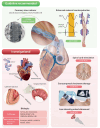Refractory angina: mechanisms and stratified treatment in obstructive and non-obstructive chronic myocardial ischaemic syndromes
- PMID: 40590516
- PMCID: PMC12500330
- DOI: 10.1093/eurheartj/ehaf284
Refractory angina: mechanisms and stratified treatment in obstructive and non-obstructive chronic myocardial ischaemic syndromes
Abstract
The diagnosis of refractory angina has conventionally been limited to patients with angina and ischaemia secondary to obstructive atherosclerotic epicardial coronary disease who experience persistent symptoms despite optimal pharmacological and revascularization therapies. It is now well-established that angina may also be caused by ischaemia resulting from coronary microcirculatory disorders, coronary vasospasm, and bridging in the absence of obstructive epicardial coronary disease or after "successful" revascularization. This increasingly prevalent and symptomatic group of patients, with both angina and demonstrable ischaemia, have been excluded from the conventional definition of refractory angina. In patients with obstructive epicardial coronary disease, disturbed microcirculatory and vasomotor function, amongst other ischaemic mechanisms, may account for continuing symptoms despite revascularization. Under-recognition of these mechanisms results in inadequate treatment and symptom persistence. In this review, a redefinition of refractory angina is proposed to include the full spectrum of patients experiencing persistent angina despite current maximal guideline-directed medical and revascularization therapies. Systematic approaches for comprehensive investigation are suggested to identify underlying mechanisms of ischaemia and stratify treatments accordingly. The complex needs of patients with refractory angina are likely best addressed by an inter-disciplinary Angina Heart Team with the aim of improving patient symptoms, quality of life, and clinical outcomes.
Keywords: ANOCA; Chronic coronary syndromes; INOCA; Non-acute myocardial ischaemic syndromes; Refractory angina pectoris.
© The Author(s) 2025. Published by Oxford University Press on behalf of the European Society of Cardiology.
Figures





References
Publication types
MeSH terms
Grants and funding
LinkOut - more resources
Full Text Sources
Medical

